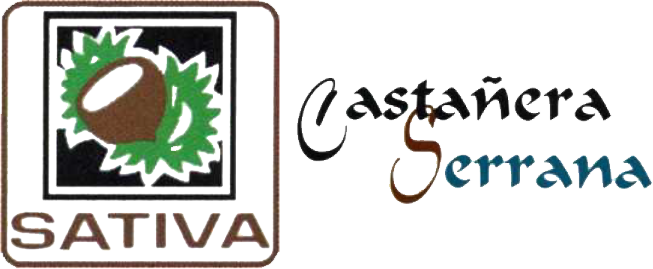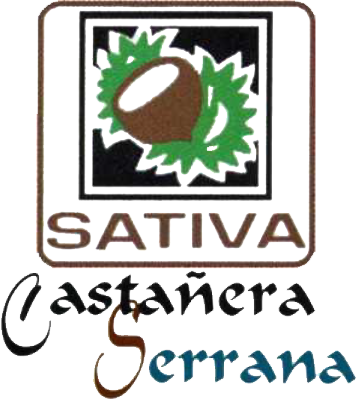Sustainable management

The chestnut tree is a long-living tree with a majestic presence. The bark of the young trees is smooth, turning grey-brown and rough with deep furrows in older specimens. Their root system is moderately deep, but very extended and robust.
The leaves, alternate and deciduous, have an oblong-lanceolate shape and are boldly toothed. The flowers are borne in long upright yellow catkins with the single male blossoms in a discontinuous disposition at the top and the female flowers at the bottom. The female flowers have an exterior protection which over time develops into spiny cupules (“Hedgehogs”). When they open, they show 1 to 5 seeds, the chestnuts. The flowering period is May to July, giving the orchards a characteristic yellow colour in this time of the year. The pollination is fundamentally anemophil (by wind), although the help of many insects that visit the flowers has to be mentioned. The fruits ripen between September and November.
The sustainable management of the chestnut orchards integrates different processes as well as agroforestal treatments for the improvement, the maintenance and the protection of the cultivation and finally the betterment of their productivity. These activities include: the planting of new saplings, the pruning, the grafting, soil treatment and fertilization.
The ideal period for planting the chestnut saplings is between November and the end of February. The preparation of the soil for planting the saplings has the purpose to ease the penetration of the soil by the roots, reason why the holes in the ground should be as deep as possible. Their depth should be between 0.5 and 1 meter, with a diameter of 1 meter. Ideally every tree should have a free space of 10 x 10 meters around them, alternately planted in parallel rows. It is also highly recommended to plant 10% more saplings, to prevent production loss and uncontrolled growth. Healthy saplings of the local wild chestnut varieties should be planted that are adapted to the local climate and soil conditions. Otherwise grafted plants that are resistant against ink disease should be purchased. The saplings should have a health certificate in order to make sure that they don’t introduce the chestnut gall wasp or other diseases (one should never buy from suppliers that don’t have health controls or that don’t offer a health warranty).
The soil should be loose and adhere to the roots. Air bubbles can make the development of the roots very difficult. There should also be no stones or lumps, these can also strongly obstruct the growing roots. The top of the root should be at least 5 cm deep in the soil in order to prevent it from being damaged. The stem should be upright and the plant should be fixed well in the soil, without compacting the soil too much; around the sapling there should be a hollow or a groove to hold back the rain or irrigation water. After planting the saplings it makes sense to water them. Later on, in order to improve the survival rate of the plants, it is highly suggested to irrigate them pointedly (micro-irrigation), specially in the first 2-3 years. A protection against wild animals (rodents, dear, wild boars) is also recommended. The entire orchard can be fenced, or the single trees can be protected with chicken wire mesh fixed to an iron rod. In the first years it is important to eliminate the brushes between the plants to prevent competition for nutrients.
A natural regeneration of the chestnut trees is recommended, be it by germinating the chestnuts (locally called “brinzales”) or by root shoots (locally called “chirpiales”), and step by step replacing the older trees.
Pruning of a tree has the purpose to sustain it’s health and give it the desired shape.

During the process unwanted branches of the tree are removed in order to optimize the desired results, be it for fruit or lumber production, or for ornamental purposes. The pruning of the chestnut trees in the region (locally called “tala”) is usually done during the winter months. The root shoots on the other hand (locally called “choqueras”) can be eliminated while green during the growth period.
Once it has been planted and grafted, it is recommended to prune it to a gobelet shape when the stem has reached a diameter of 7 cm at it’s base. This first pruning consists of the elimination of the tree’s main stem at a height of 2-2.5 meters. The following prunings have the goal to leave only 4 or more primary branches. In the following years, maintenance pruning eliminates the young competing shoots (called “chupones”) and it is attempted to give the tree a homogeneous shape. When the tree is established, pruning is done every four years, cutting off deformed secondary and tertiary branches, sick or dead wood, crossed branches or ones that are too near to each other.
The pruning types suggested for the maintenance and conservation of the young chestnut trees is the crown canopy lifting and on established trees those of form-giving and health maintenance. Another type of pruning is the one aimed at obtaining a thick trunk or to obtain poles, should the chestnut be dedicated to the production of lumber. Worker safety and risk prevention must be assured by using fall protection gear that minimizes the risks of working at height.
Grafting is a technique that inserts one or more shoots of a different variety of chestnut into the trunk or the main branches of the rootstock (locally called “patrón”). There are different techniques, and every technician can use the one they know best. The best time to do it is in the beginning of spring, when the sap begins to flow. The inserts are taken from one year old branches, always green, and from scions that have been selected for the quality of it’s fruits, it’s growth etc. In new plantations it is advisable to graft inserts of the desired variety taken from a tree nursery that are free of diseases.
Even if the tree stock needs to be grafted in order to guarantee the productivity of the orchard, to optimize pollination it is recommended to keep 10-20% of ungrafted trees along the property borders and in strategic tree-brush areas of the orchard.
It is recommended to graft scions of the desired variety onto wild rootstocks. These scions have to be treated against disease as well as bites of wild and cattle.
The tilling of the soil with ploughs is very common. Although it is said that this has always been the case, it does not correspond to reality as mechanical ploughing done with tractors has only been done since a relatively short time (since mid twentieth century). In the past the ploughing of the soil in the chestnut orchards was done with traditional ploughs pulled by animals in order to prepare the soil for the planting of fodder plants for the cattle.
The soil, on which today’s chestnuts orchards are standing has been altered by the successive mechanical tillings. This has caused a loss of fertile soil (horizon A), which has disappeared in many chestnut orchards on vegetationless slopes due to rain run-off. At the same time, the tilling can cause the propagation of the ink-disease fungus, because it damages the roots and facilitates infection of the trees. Mechanical tilling causes loss of biodiversity and contributes to global warming and climate change. That is the reason why we suggest to abstain from mechanical tilling and to opt instead for a selective clearing of the vegetation with a rotary cutter, leaving grasses, brushes and trees outside of the area covered by the crowns of the trees and along the property limits intact, thus maintaining the biodiversity in those areas where it does not compromise the harvest of the chestnuts and slowing down the effects of strong rainfalls. This further helps to maintain the retention of humidity and the fertile soil.
The edaphic fertility of an ecosystem with high biodiversity makes sure necessary nutrients are available. If fertilization is necessary, the use of solid organic fertilizer is suggested, that is, fertilizer of animal, vegetal or mixed origin. Inorganic fertilizers are not suggested seen the negative impact their use can have on the environment. The fertilizer has to be applied before planting the orchard and after the harvest. As to their dosification, seen the great variety of organic fertilizers available, it is best to have the soil analyzed in order to know the nutrient deficiency of the same (nitrogen, potassium, phosphorus…) and to determine the optimal quantity necessary for each hectare.
Equally important would be to reintegrate the cuttings resulting from clearings and prunings back into the soil by grinding, hacking or splintering the bigger parts. The decomposition of these plant cuttings is, together with the decomposition of other organic remnants and the disintegration and dissolution of the minerals contained in the base rock, very important for the nutrition of the trees. Burning these vegetable remnants brings with it a potential diminution of their natural nutrients. It is therefore only suggested for the elimination of infected cuttings, or when for some reason they cannot be ground up, hacked or splintered to pieces by the described processes.


